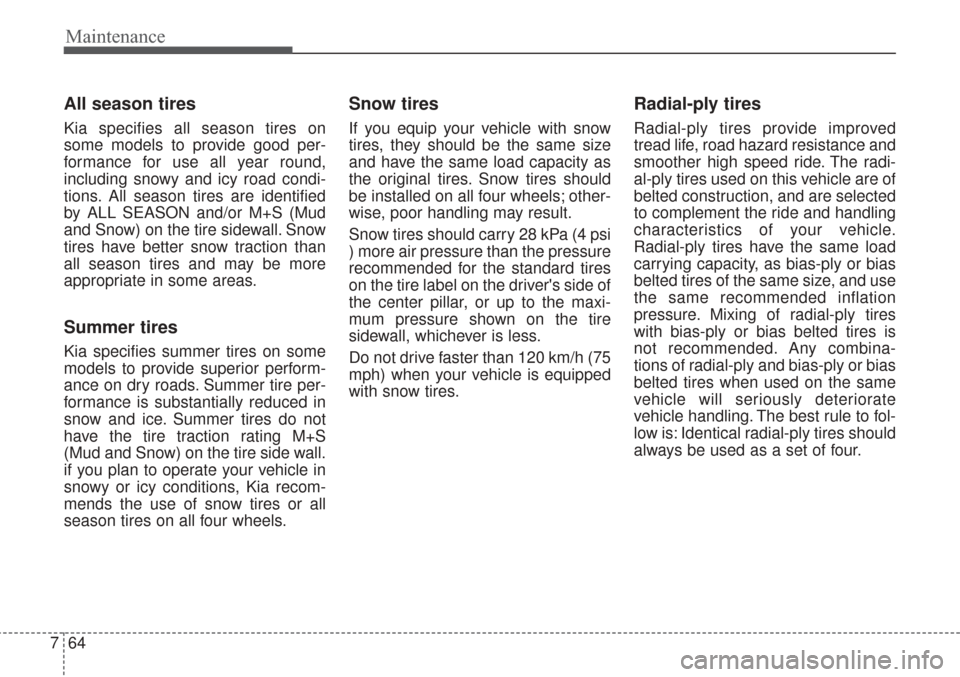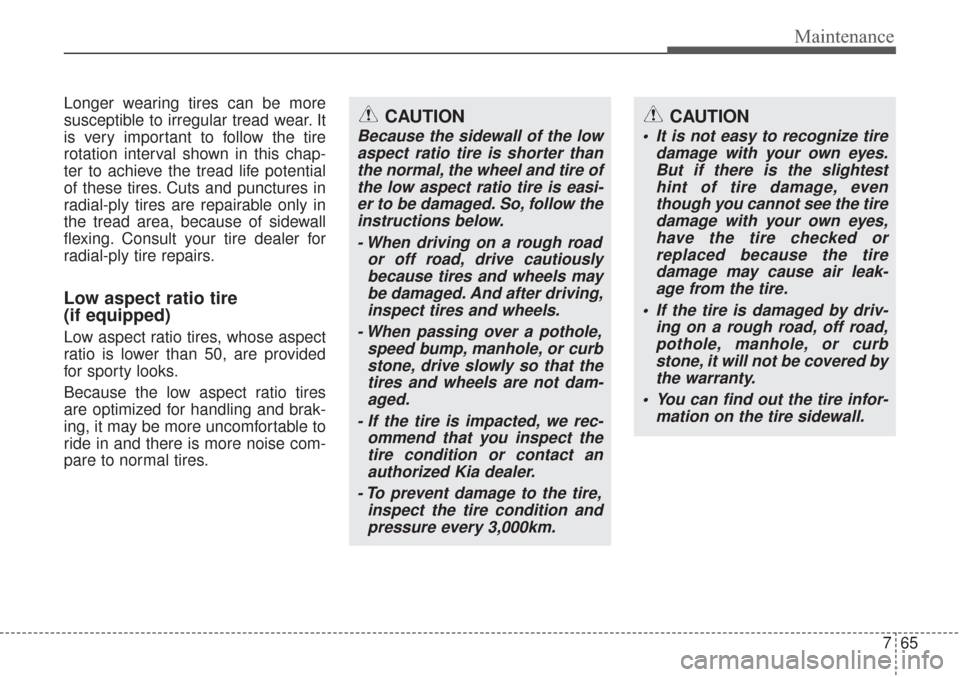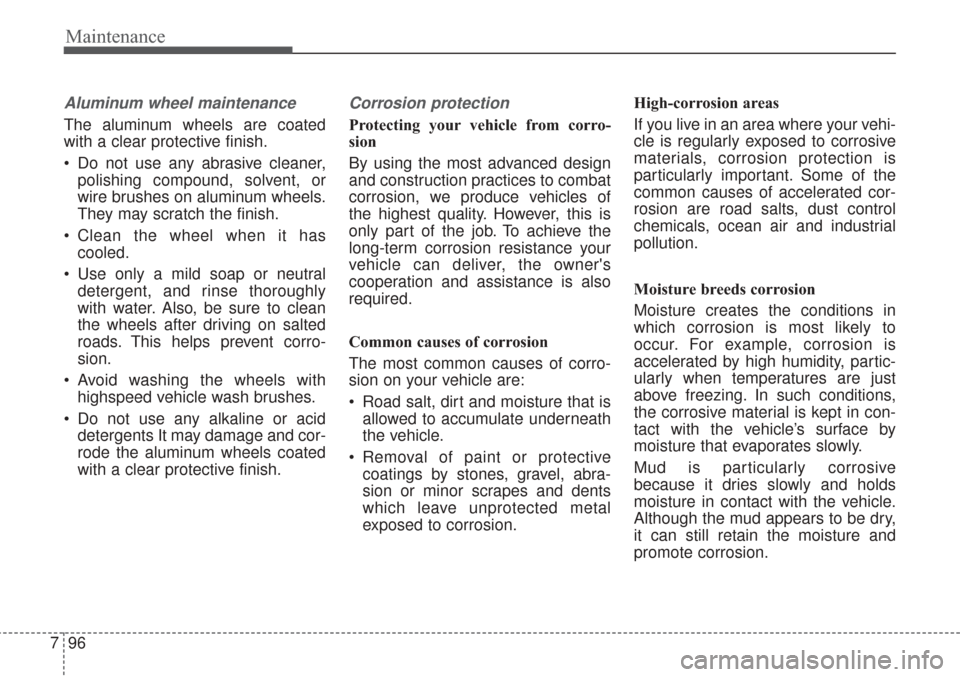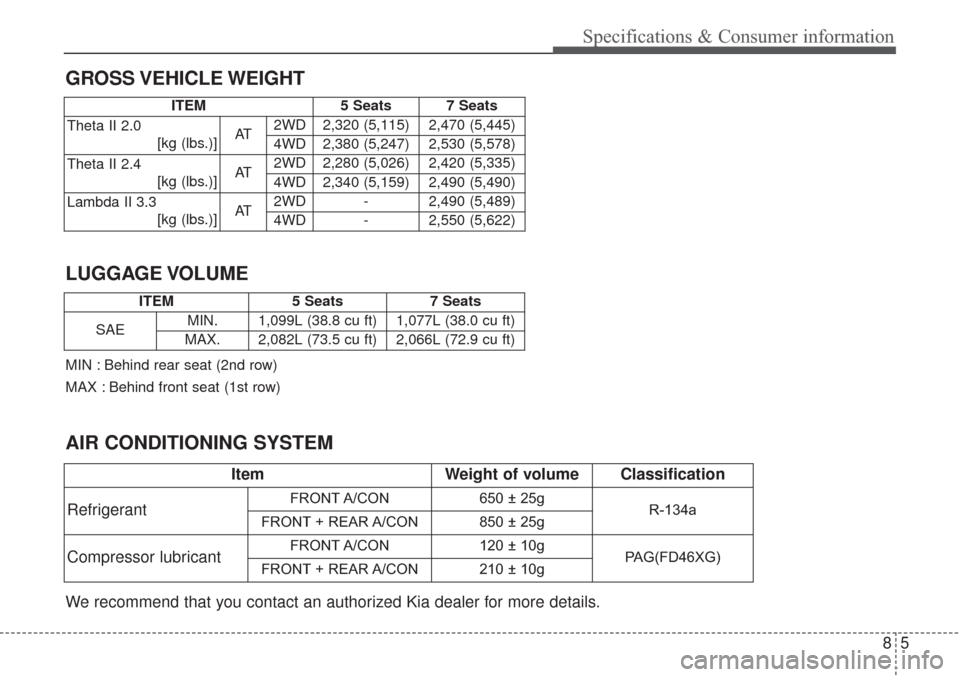2017 KIA Sorento air condition
[x] Cancel search: air conditionPage 513 of 576

761
Maintenance
Traction - AA, A, B & C
The traction grades, from highest to
lowest, are AA, A, B and C. Those
grades represent the tire’s ability to
stop on wet pavement as measured
under controlled conditions on spec-
ified government test surfaces of
asphalt and concrete. A tire marked
C may have poor traction perform-
ance.
The traction grade assigned to this
tire is based on straight-ahead brak-
ing traction tests, and does not
include acceleration, cornering,
hydroplaning, or peak traction char-
acteristics.Temperature -A, B & C
The temperature grades are A (the
highest), B and C representing the
tire’s resistance to the generation of
heat and its ability to dissipate heat
when tested under controlled condi-
tions on a specified indoor laboratory
test wheel.
Sustained high temperature can
cause the material of the tire to
degenerate and reduce tire life, and
excessive temperature can lead to
sudden tire failure. Grades B and A
represent higher levels of perform-
ance on the laboratory test wheel
than the minimum required by law.
Tire terminology and definitions
Air Pressure:
The amount of air
inside the tire pressing outward on
the tire. Air pressure is expressed in
pounds per square inch (psi) or kilo-
pascal (kPa).
Accessory Weight: This means the
combined weight of optional acces-
sories. Some examples of optional
accessories are, automatic
transaxle, power seats, and air con-
ditioning.
Aspect Ratio: The relationship of a
tire's height to its width.
Belt: A rubber coated layer of cords
that is located between the plies and
the tread. Cords may be made from
steel or other reinforcing materials.
Bead: The tire bead contains steel
wires wrapped by steel cords that
hold the tire onto the rim.
Bias Ply Tire: A pneumatic tire in
which the plies are laid at alternate
angles less than 90 degrees to the
centerline of the tread.
Page 516 of 576

Maintenance
64
7
All season tires
Kia specifies all season tires on
some models to provide good per-
formance for use all year round,
including snowy and icy road condi-
tions. All season tires are identified
by ALL SEASON and/or M+S (Mud
and Snow) on the tire sidewall. Snow
tires have better snow traction than
all season tires and may be more
appropriate in some areas.
Summer tires
Kia specifies summer tires on some
models to provide superior perform-
ance on dry roads. Summer tire per-
formance is substantially reduced in
snow and ice. Summer tires do not
have the tire traction rating M+S
(Mud and Snow) on the tire side wall.
if you plan to operate your vehicle in
snowy or icy conditions, Kia recom-
mends the use of snow tires or all
season tires on all four wheels.
Snow tires
If you equip your vehicle with snow
tires, they should be the same size
and have the same load capacity as
the original tires. Snow tires should
be installed on all four wheels; other-
wise, poor handling may result.
Snow tires should carry 28 kPa (4 psi
) more air pressure than the pressure
recommended for the standard tires
on the tire label on the driver's side of
the center pillar, or up to the maxi-
mum pressure shown on the tire
sidewall, whichever is less.
Do not drive faster than 120 km/h (75
mph) when your vehicle is equipped
with snow tires.
Radial-ply tires
Radial-ply tires provide improved
tread life, road hazard resistance and
smoother high speed ride. The radi-
al-ply tires used on this vehicle are of
belted construction, and are selected
to complement the ride and handling
characteristics of your vehicle.
Radial-ply tires have the same load
carrying capacity, as bias-ply or bias
belted tires of the same size, and use
the same recommended inflation
pressure. Mixing of radial-ply tires
with bias-ply or bias belted tires is
not recommended. Any combina-
tions of radial-ply and bias-ply or bias
belted tires when used on the same
vehicle will seriously deteriorate
vehicle handling. The best rule to fol-
low is: Identical radial-ply tires should
always be used as a set of four.
Page 517 of 576

765
Maintenance
Longer wearing tires can be more
susceptible to irregular tread wear. It
is very important to follow the tire
rotation interval shown in this chap-
ter to achieve the tread life potential
of these tires. Cuts and punctures in
radial-ply tires are repairable only in
the tread area, because of sidewall
flexing. Consult your tire dealer for
radial-ply tire repairs.
Low aspect ratio tire
(if equipped)
Low aspect ratio tires, whose aspect
ratio is lower than 50, are provided
for sporty looks.
Because the low aspect ratio tires
are optimized for handling and brak-
ing, it may be more uncomfortable to
ride in and there is more noise com-
pare to normal tires.
CAUTION
Because the sidewall of the lowaspect ratio tire is shorter thanthe normal, the wheel and tire ofthe low aspect ratio tire is easi-er to be damaged. So, follow theinstructions below.
- When driving on a rough road or off road, drive cautiouslybecause tires and wheels maybe damaged. And after driving,inspect tires and wheels.
- When passing over a pothole, speed bump, manhole, or curbstone, drive slowly so that thetires and wheels are not dam-aged.
- If the tire is impacted, we rec- ommend that you inspect thetire condition or contact anauthorized Kia dealer.
- To prevent damage to the tire, inspect the tire condition andpressure every 3,000km.
CAUTION
It is not easy to recognize tire damage with your own eyes.But if there is the slightesthint of tire damage, eventhough you cannot see the tiredamage with your own eyes,have the tire checked orreplaced because the tiredamage may cause air leak-age from the tire.
If the tire is damaged by driv- ing on a rough road, off road,pothole, manhole, or curbstone, it will not be covered bythe warranty.
You can find out the tire infor- mation on the tire sidewall.
Page 548 of 576

Maintenance
96
7
Aluminum wheel maintenance
The aluminum wheels are coated
with a clear protective finish.
Do not use any abrasive cleaner,
polishing compound, solvent, or
wire brushes on aluminum wheels.
They may scratch the finish.
Clean the wheel when it has cooled.
Use only a mild soap or neutral detergent, and rinse thoroughly
with water. Also, be sure to clean
the wheels after driving on salted
roads. This helps prevent corro-
sion.
Avoid washing the wheels with highspeed vehicle wash brushes.
Do not use any alkaline or acid detergents It may damage and cor-
rode the aluminum wheels coated
with a clear protective finish.
Corrosion protection
Protecting your vehicle from corro-
sion
By using the most advanced design
and construction practices to combat
corrosion, we produce vehicles of
the highest quality. However, this is
only part of the job. To achieve the
long-term corrosion resistance your
vehicle can deliver, the owner's
cooperation and assistance is also
required.
Common causes of corrosion
The most common causes of corro-
sion on your vehicle are:
Road salt, dirt and moisture that isallowed to accumulate underneath
the vehicle.
coatings by stones, gravel, abra-
sion or minor scrapes and dents
which leave unprotected metal
exposed to corrosion. High-corrosion areas
If you live in an area where your vehi-
cle is regularly exposed to corrosive
materials, corrosion protection is
particularly important. Some of the
common causes of accelerated cor-
rosion are road salts, dust control
chemicals, ocean air and industrial
pollution.
Moisture breeds corrosion
Moisture creates the conditions in
which corrosion is most likely to
occur. For example, corrosion is
accelerated by high humidity, partic-
ularly when temperatures are just
above freezing. In such conditions,
the corrosive material is kept in con-
tact with the vehicle’s surface by
moisture that evaporates slowly.
Mud is particularly corrosive
because it dries slowly and holds
moisture in contact with the vehicle.
Although the mud appears to be dry,
it can still retain the moisture and
promote corrosion.
Page 555 of 576

7103
Maintenance
Do not operate the engine in con-fined or closed areas (such as
garages) any more than what is
necessary to move the vehicle in or
out of the area.
When the vehicle is stopped in an open area for more than a short
time with the engine running,
adjust the ventilation system (as
needed) to draw outside air into the
vehicle.
Never sit in a parked or stopped vehicle for any extended time with
the engine running.
When the engine stalls or fails to start, excessive attempts to restart
the engine may cause damage to
the emission control system.Operating precautions for catalyt-
ic converters (if equipped)
WARNING- Catalytic converter
Keep away from the catalytic
converter and exhaust system
while the vehicle is running or
immediately thereafter. The
exhaust and catalytic systems
are very hot and may burn you.
WARNING- Fire
Do not park, idle or drive the vehicle over or near flamma-
ble objects, such as grass,
vegetation, paper, leaves, etc.
A hot exhaust system can
ignite flammable items under
your vehicle.
Also, do not remove the heat sink around the exhaust sys-
tem, do not seal the bottom of
the vehicle or do not coat the
vehicle for corrosion control.
It may present a fire risk under
certain conditions.
Page 557 of 576

Specifications & Consumer information
Dimensions . . . . . . . . . . . . . . . . . . . . . . . . . . . . . . . . 8-2
Engine . . . . . . . . . . . . . . . . . . . . . . . . . . . . . . . . . . . . 8-2
Bulb wattage . . . . . . . . . . . . . . . . . . . . . . . . . . . . . . . 8-3
Tires and wheels . . . . . . . . . . . . . . . . . . . . . . . . . . . . 8-4
Gross vehicle weight. . . . . . . . . . . . . . . . . . . . . . . . . 8-5
Luggage volume . . . . . . . . . . . . . . . . . . . . . . . . . . . . 8-5
Air conditioning system . . . . . . . . . . . . . . . . . . . . . . 8-5
Recommended lubricants and capacities . . . . . . . 8-6
• Recommended SAE viscosity number. . . . . . . . . . . . . 8-8
Vehicle identification number (VIN) . . . . . . . . . . . 8-9
Vehicle certification label. . . . . . . . . . . . . . . . . . . . . 8-9
Tire specification and pressure label . . . . . . . . . . 8-10
Engine number . . . . . . . . . . . . . . . . . . . . . . . . . . . . 8-10
8
Page 561 of 576

85
GROSS VEHICLE WEIGHTSpecifications & Consumer information
AIR CONDITIONING SYSTEM LUGGAGE VOLUME
ItemWeight of volume Classification
Refrigerant
FRONT A/CON650 ± 25g
R-134a
FRONT + REAR A/CON850 ± 25g
Compressor lubricantFRONT A/CON120 ± 10gPAG(FD46XG)FRONT + REAR A/CON210 ± 10g
We recommend that you contact an authorized Kia dealer for more details.
ITEM5 Seats7 Seats
Theta II 2.0
[kg (lbs.)]AT2WD2,320 (5,115)2,470 (5,445)
4WD2,380 (5,247)2,530 (5,578)
Theta II 2.4
[kg (lbs.)]AT2WD2,280 (5,026)2,420 (5,335)
4WD2,340 (5,159)2,490 (5,490)
Lambda II 3.3
[kg (lbs.)]AT2WD-2,490 (5,489)
4WD-2,550 (5,622)
ITEM5 Seats7 Seats
SAEMIN.1,099L (38.8 cu ft)1,077L (38.0 cu ft)
MAX.2,082L (73.5 cu ft)2,066L (72.9 cu ft)
MIN : Behind rear seat (2nd row)
MAX : Behind front seat (1st row)
Page 568 of 576

Index
2I
Advanced smart cruise control system (ASCC) . . . . . . 5-65Limitations of the system . . . . . . . . . . . . . . . . . . . . . 5-75
Speed setting (ASCC) . . . . . . . . . . . . . . . . . . . . . . . 5-66
To adjust the sensitivity of advanced smartcruise control . . . . . . . . . . . . . . . . . . . . . . . . . . . . . 5-74
To convert to cruise control mode . . . . . . . . . . . . . . 5-75
Vehicle to vehicle distance setting (ASCC) . . . . . . . 5-70
Air bag - advanced supplemental restraint system . . . 3-44 Air bag warning label. . . . . . . . . . . . . . . . . . . . . . . . 3-68
Air bag warning light . . . . . . . . . . . . . . . . . . . . . . . . 3-47
Curtain air bag . . . . . . . . . . . . . . . . . . . . . . . . . . . . . 3-61
Do not install a child restraint on the frontpassenger’s seat . . . . . . . . . . . . . . . . . . . . . . . . . . . 3-47
Driver's and passenger's front air bag . . . . . . . . . . . 3-57
How does the air bag system operate . . . . . . . . . . . 3-45
Inflation and non-inflation conditions of the air bag . . 3-62
Occupant Detection System (ODS) . . . . . . . . . . . . . 3-51
Side air bag. . . . . . . . . . . . . . . . . . . . . . . . . . . . . . . . 3-59
SRS Care . . . . . . . . . . . . . . . . . . . . . . . . . . . . . . . . . 3-67
SRS components and functions . . . . . . . . . . . . . . . . 3-48
Air cleaner . . . . . . . . . . . . . . . . . . . . . . . . . . . . . . . . . . 7-42\
Filter replacement. . . . . . . . . . . . . . . . . . . . . . . . . . . 7-42
Air conditioning system . . . . . . . . . . . . . . . . . . . . . . . . . 8-5
All wheel drive (AWD) . . . . . . . . . . . . . . . . . . . . . . . . 5-20 All wheel drive (AWD) transfer mode selection . . . 5-22
For safe all wheel drive operation . . . . . . . . . . . . . . 5-23
Tight corner brake effect . . . . . . . . . . . . . . . . . . . . . 5-21 Appearance care . . . . . . . . . . . . . . . . . . . . . . . . . . . . . . 7-91
Exterior care . . . . . . . . . . . . . . . . . . . . . . . . . . . . . . . 7-91
Interior care . . . . . . . . . . . . . . . . . . . . . . . . . . . . . . . 7-98
Autonomous Emergency Braking (AEB)/ Forward Collision Warning (FCW) . . . . . . . . . . . . 5-50
AEB warning message and system control . . . . . . . 5-52
Brake operation . . . . . . . . . . . . . . . . . . . . . . . . . . . . 5-54
Limitation of the system . . . . . . . . . . . . . . . . . . . . . 5-56
Recognizing pedestrians. . . . . . . . . . . . . . . . . . . . . . 5-59
Sensor to detect the distance from the vehicle in front (front radar) . . . . . . . . . . . . . . . . . . . . . . . . 5-54
System malfunction . . . . . . . . . . . . . . . . . . . . . . . . . 5-55
System setting and activation. . . . . . . . . . . . . . . . . . 5-50
Audio system . . . . . . . . . . . . . . . . . . . . . . . . . . . . . . . 4-172 Antenna . . . . . . . . . . . . . . . . . . . . . . . . . . . . . . . . . 4-172
AUX, USB and iPod
®port . . . . . . . . . . . . . . . . . . 4-174
How vehicle audio works. . . . . . . . . . . . . . . . . . . . 4-175
Steering wheel remote controller . . . . . . . . . . . . . . 4-173
Using iPod
®device . . . . . . . . . . . . . . . . . . . . . . . . 4-180
Using the USB device . . . . . . . . . . . . . . . . . . . . . . 4-179
Automatic climate control system . . . . . . . . . . . . . . . 4-141 3rd row air conditioning. . . . . . . . . . . . . . . . . . . . . 4-149
Automatic heating and air conditioning. . . . . . . . . 4-143
Checking the amount of air conditionerrefrigerant and compressor lubricant . . . . . . . . . . 4-153
Climate control air filter. . . . . . . . . . . . . . . . . . . . . 4-152
Manual heating and air conditioning . . . . . . . . . . . 4-144
System operation . . . . . . . . . . . . . . . . . . . . . . . . . . 4-150
A